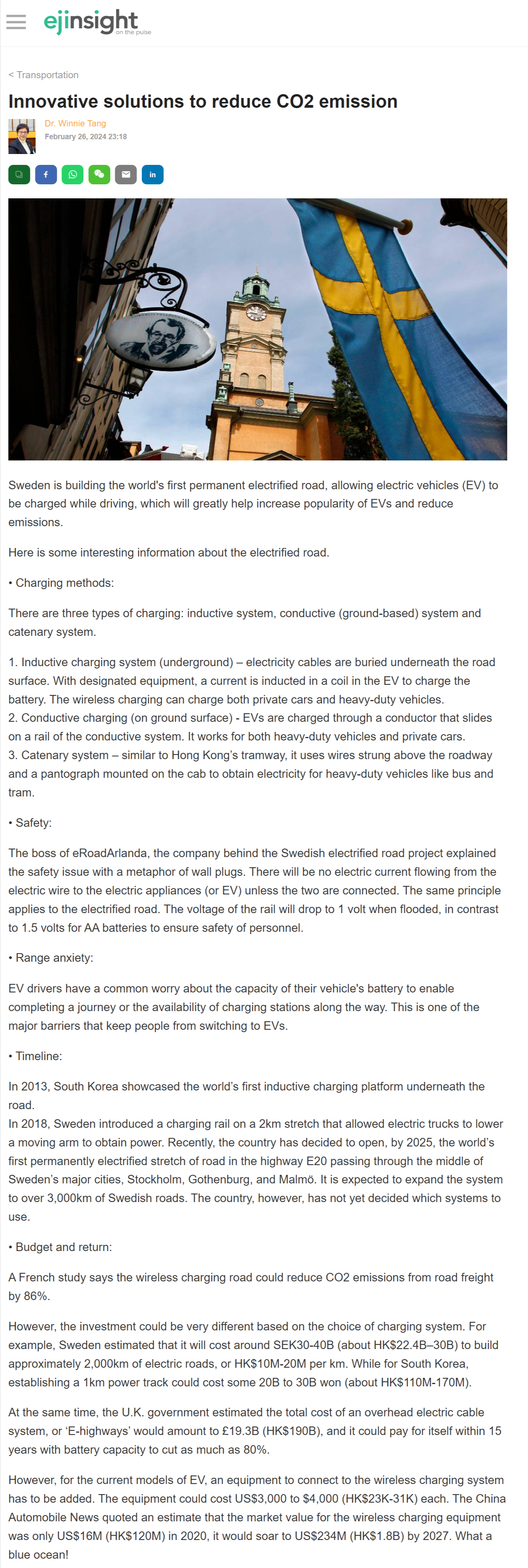網上版請按此

Innovative solutions to reduce CO2 emission
Sweden is building the world's first permanent electrified road, allowing electric vehicles (EV) to be charged while driving, which will greatly help increase popularity of EVs and reduce emissions.
Here is some interesting information about the electrified road.
• Charging methods:
There are three types of charging: inductive system, conductive (ground-based) system and catenary system.
1. Inductive charging system (underground) – electricity cables are buried underneath the road surface. With designated equipment, a current is inducted in a coil in the EV to charge the battery. The wireless charging can charge both private cars and heavy-duty vehicles.
2. Conductive charging (on ground surface) - EVs are charged through a conductor that slides on a rail of the conductive system. It works for both heavy-duty vehicles and private cars.
3. Catenary system – similar to Hong Kong's tramway, it uses wires strung above the roadway and a pantograph mounted on the cab to obtain electricity for heavy-duty vehicles like bus and tram.
• Safety:
The boss of eRoadArlanda, the company behind the Swedish electrified road project explained the safety issue with a metaphor of wall plugs. There will be no electric current flowing from the electric wire to the electric appliances (or EV) unless the two are connected. The same principle applies to the electrified road. The voltage of the rail will drop to 1 volt when flooded, in contrast to 1.5 volts for AA batteries to ensure safety of personnel.
• Range anxiety:
EV drivers have a common worry about the capacity of their vehicle's battery to enable completing a journey or the availability of charging stations along the way. This is one of the major barriers that keep people from switching to EVs.
• Timeline:
In 2013, South Korea showcased the world's first inductive charging platform underneath the road.
In 2018, Sweden introduced a charging rail on a 2km stretch that allowed electric trucks to lower a moving arm to obtain power. Recently, the country has decided to open, by 2025, the world's first permanently electrified stretch of road in the highway E20 passing through the middle of Sweden's major cities, Stockholm, Gothenburg, and Malmö. It is expected to expand the system to over 3,000km of Swedish roads. The country, however, has not yet decided which systems to use.
• Budget and return:
A French study says the wireless charging road could reduce CO2 emissions from road freight by 86%.
However, the investment could be very different based on the choice of charging system. For example, Sweden estimated that it will cost around SEK30-40B (about HK$22.4B–30B) to build approximately 2,000km of electric roads, or HK$10M-20M per km. While for South Korea, establishing a 1km power track could cost some 20B to 30B won (about HK$110M-170M).
At the same time, the U.K. government estimated the total cost of an overhead electric cable system, or 'E-highways' would amount to £19.3B (HK$190B), and it could pay for itself within 15 years with battery capacity to cut as much as 80%.
However, for the current models of EV, an equipment to connect to the wireless charging system has to be added. The equipment could cost US$3,000 to $4,000 (HK$23K-31K) each. The China Automobile News quoted an estimate that the market value for the wireless charging equipment was only US$16M (HK$120M) in 2020, it would soar to US$234M (HK$1.8B) by 2027. What a blue ocean!
Dr. Winnie Tang
Adjunct Professor, Department of Computer Science, Faculty of Engineering; Department of Geography, Faculty of Social Sciences; and Faculty of Architecture, The University of Hong Kong